Tablature is a music notation system based on where the player’s fingers are placed on the instrument rather than on just the musical pitches that are heard. Although first used over 700 years ago to score music for the organ, it has been most often used to notate music for fretted instruments such as the lyre and guitar.
Currently, tablature is commonly used to notate music for the guitar or electric bass. The quality of available tablature can vary widely, so I’ve put together this guide to help you find the best sources of tablature for guitar and bass.
I began playing the guitar over 30 years ago, and have used tablature since the start. In those years, I have found many good sources of tablature, as well as some that were not as good. I own tablature books from a number of companies. I have found tablature in guitar magazines and websites. I have even written my own music using tablature. Using the knowledge that I have gained, I hope to show you how to find high-quality tablature that you can use.
Standard Notation vs Tablature
Standard notation is written on a staff of five lines, with each line and space delegated to a certain note. Music for most instruments is written using standard notation. When the subject of “reading music” arises, it almost always refers to the ability to understand standard notation. Standard notation is a very effective tool for telling the player not just the pitch of a note, but also its duration and any rhythmic characteristics.
Tablature is written on a staff that has a line for each string of the instrument for which it is written. While other possibilities exist, most guitar tablature will be written on six lines and most bass tablature on four. Rather than just providing the pitch to be played as is done in standard notation, tablature explicitly states at which fret the finger should be placed to play that note.
There are advantages and disadvantages to each type of notation.
Ease of Reading
Beginners with little experience reading music will find tablature to be much more user-friendly than standard notation. Tablature illustrates exactly how the piece of music should be played, requiring little interpretation by the player. A player who has never used tablature can quickly learn the symbols used (usually supplied in a key).
With that knowledge, the player can learn and play a new song very quickly. Although many experienced players can read standard notation with enough skill to play a new song upon first reading it, this is a difficult skill for new players to learn quickly.
Determining the Best Fingering Position
Standard notation shows the pitch to be played, but not the correct position to use. This is not an issue for musicians who play most instruments, but it can be a problem for guitarists and electric bass players.
A pianist may play a certain pitch on only one key, but a guitarist or bassist can play that same specific pitch on different strings in different positions on the fretboard. Tablature notes exactly where on the fretboard each pitch should be played. A player must determine which position is best when using standard notation, as that information is not provided.
Using standard notation could result in a player actually playing a song in a different way than it was originally played. This may not be an altogether bad thing, but it might end up being a more difficult way to play the piece.
In addition to noting the proper fingering position to use, tablature also often informs the reader which fingers to use for specific notes. This notation can be quite useful when learning to play difficult passages or phrases, as certain fingerings can ease position changes or movement from one string to another. Standard notation can also be used to specify certain fingerings, but it is not very common.
Determining Pitch
Tablature illustrates exactly how a note is to be fingered, but it does not tell the reader the pitch of the fingered note. This limitation can hinder the player’s learning to identify the notes on the fretboard. As a purely practical tool, tablature gives the player instruction on how to play a song.
However, it falls behind standard notation in aiding a player’s understanding of how those notes work together. Anyone interested in studying harmony and music theory will benefit from learning to read standard notation as well as tablature.
Tablature is also very useful for musical pieces written in tunings other than standard guitar tuning (EADGBE for guitar, EADG for bass). An alternate tuning, or scordatura, requires writing in a different key in standard notation.
For example, let’s consider a musical piece written in E flat major. If an instrument is tuned a semitone higher than standard, its part would be written in D major. Due to its tuning, the instrument would actually produce notes sounding in E flat major, matching the other instruments in the ensemble.
Using tablature, an alternate tuning is simply stated and the fingerings are noted just as if the instrument was in standard tuning. Tablature does not explicitly state the pitch of a note, so there is no need to notate differently for alternate tunings; the 12th fret is always the 12th fret.
Determining Rhythm and Timing
Standard notation far exceeds tablature in regard to providing the player with information about rhythm and timing. Most tablature provides very little information about these important facets of a musical piece. Knowing the correct positions and fingerings to use for a piece of music is valuable, but without any notation as to the duration of the notes, it is unlikely that a player will be able to reproduce the piece as it should be played.
Of course, listening to a recording of the piece can give the player this information. But without hearing the piece of music, it is highly unlikely that a player will be able to correctly play the piece with the correct timing through using tablature alone.
Some tablature writers seek to correct this tablature shortcoming by attempting to combine standard notation and tablature, adding note stems, flags and beams to the fret numbers used in tablature. This style is not very common, and I find it to be a less neat and somewhat distracting form of notation.
The difficulty in notating timing using tablature is a major limitation when writing for a polyphonic instrument such as the guitar. A polyphonic instrument is an instrument that is capable of producing multiple notes at the same time.
Fingerstyle guitarists make use of this ability frequently, often playing a melody while simultaneously maintaining a chordal rhythm. Without the ability to inform a player of the note values, it is difficult to show that such a song is made up of two parts being played on the same instrument.
Universality
Any player or writer can use standard notation. The ability to read and write in this style of notation gives a player a greater ability to communicate with musicians who play different instruments. A guitarist may create a melody on guitar but write it in standard notation so that it may be played on the violin.
Conversely, a guitarist can also learn pieces usually played on different instruments. I remember a period in which many electric guitarists were using standard notation to learn violin pieces written by Paganini and Bach.
Tablature is of limited use for any instrument other than the one for which it was written. A guitarist may be able to make some use of bass tablature, but it will be of no worth to an oboe player. A pianist cannot learn a song using tablature written for a banjo. Many musical works have never been transcribed from standard notation to tablature, and possibly never will be.
Ease of Writing
For centuries, standard notation was written by hand. Today, writing in standard notation on a computer requires special software designed for this purpose. Writing high-quality tablature also requires software, but a more basic form of tablature can be written in a standard computer ASCII text file.
Numbers, letters, and symbols are used to build the tablature. As limited as this musical notation style can be, it has made it incredibly easy to share tablature electronically. There are a number of websites which collect and share tablature written using this method.
My Recommendations
Considering the limitations of both standard notation and tablature, I prefer having both at the same time. High-quality tablature sources commonly provide a hybrid of the two styles, with the standard staff appearing over the tablature staff.
This approach allows a player to have the timing and rhythmic information given by standard notation, as well as the tablature’s specific positions and fingerings that work best for the piece of music.
This hybrid style of notation is used by three of the best tablature companies: Hal Leonard, Cherry Lane Music, and Alfred Music.
Hal Leonard is the world’s largest publisher of songbooks and tablature, with a catalog that includes more than 200,000 titles. The accuracy of any tablature depends on the skill of the transcriptionist that wrote it. Hal Leonard has built its name upon its accuracy.
It’s possible that any tablature will be imperfect unless it is written by the artist himself, but I have found Hal Leonard tablatures to be among the most accurate versions available. Hal Leonard tablature books range in price from about $7.00 for a single book to as high as $75.00 for certain collections, with most books selling for $20-30. Bass tablature books generally sell for $15-25.
Cherry Lane Music is another tablature publisher that is well-known for providing accurate transcriptions. Cherry Lane’s “Play It Like It Is” series is designed to provide the most accurate tablature possible, with some books in the series bearing an “Artist-Approved” logo.
The books with this logo include tablature that has been personally approved as accurate by the artist. Cherry Lane guitar tablature books usually sell for $20-25, and the bass tablature books typically have a price range of $15-25.
Alfred Music has been providing sheet music and music education tools for decades. Its catalog includes over 150,000 products, including tablature books for music by Bruce Springsteen, the Who, Led Zeppelin, the Rolling Stones, and many more popular artists.
The company claims to provide tablature with “unprecedented accuracy.” Most Alfred Music guitar tablature books sell for around $25-35. The bass tablature is generally priced $17-25.
Tablature Websites
There are numerous websites devoted to tablature. The majority of the tablature on these sites is submitted by the site’s users. As one might expect, this leads to variable quality. While there are some songs notated using software, much of the tablature is created in ASCII text.
There is little to no rhythmic information for most songs. Because few of the sites curate the content at all, the transcription accuracy can range from decent to abysmal.
The best tablature website I have found is Songsterr. Songsterr uses user-submitted tablature, but other users may edit and correct entries. In addition, a team of editors makes corrections and monitors user edits to ensure quality.
One of the great features of Songsterr is its online tablature player. Users have the option to have audio played to accompany the tablature. This feature allows the user to better understand how the notation fits with the song. As the audio is played, a cursor automatically scrolls through the tablature so that the reader can see which note is being played at that moment.
The tablature on Songsterr does not include a separate standard staff, but does have some rhythmic notation. With the ability to use the accompanying audio as a reference, I can overlook this shortcoming.
Anyone can use Songsterr. Many players will be happy with the free plan, but those players who would appreciate the additional features can purchase the paid plan for $9.90 per month. Unlike many tablature websites, Songsterr is completely legal. The fees for the paid plan are used to pay royalties to the songwriters whose work appears on the site. With over 500,000 songs by 40,000 artists, Songsterr is a website that I highly recommend to all players.
Tablature Software
I recommend Guitar Pro to those players who want to try tablature software. It allows the user to play and read tablature downloaded from the internet, or to create their own tablature.
Guitar Pro has an excellent playback feature. Its included instrument sounds aren’t perfect, but they are realistic enough to not be a distraction. The software can play multiple instruments at the same time. If your tablature includes drums, bass, guitar, or any other instruments, you will be able to hear how they sound together. With a variety of instruments available, users can try their hand at writing for everything from banjo to piano to a full orchestra.
Guitar Pro provides the user with several useful tools. Editing is easily done with the click of the mouse or with keyboard shortcuts. Users can add text notes, change time signatures, change keys, and make many other edits. Guitar Pro can also identify chords, suggest scales, and loop sections of the tablature.
Its “Speed Trainer” allows the user to slow down a looped section for focused practice. The software then slowly increases the speed with each repetition.
Guitar Pro offers a free trial version, with some limited functionality. Pricing for the full software starts around $60.
In conclusion, with the variety of tablature products available today, learning and writing music for guitar and bass is easier than ever. However, the most important tool is still the musician’s ear. Tablature is a transcription, a notation of what its writer believes was played.
Players who use tablature should always listen carefully and refer to the original recordings whenever possible. Doing so will not only help to identify any potential inaccuracies, it will also help to develop critical listening skills and serve as ear training.
Sources
- Shawn Bradshaw, “Converting Standard Notation To Guitar Tablature,” Cyberfret, accessed December 20, 2016.
- UG Team, “How to Read Tabs,” Ultimate Guitar, October 18, 2013.
- Wikipedia contributors, “Cherry Lane Music,” Wikipedia, The Free Encyclopedia, accessed December 20, 2016.
- “About,” Songsterr, accessed December 21, 2016.
- Aaron Matthies, “Guitar Pro 6 Review,” Guitar Gear Finder, April 28, 2014.

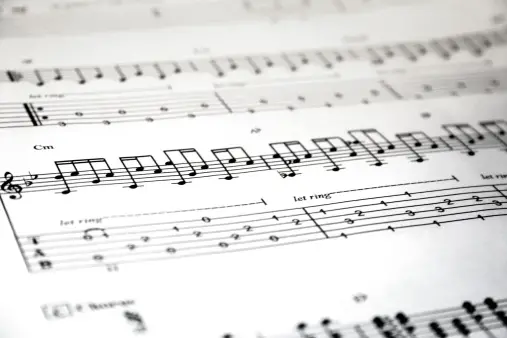
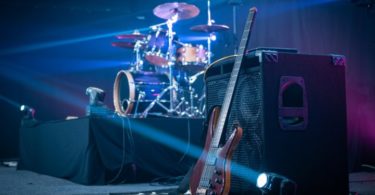
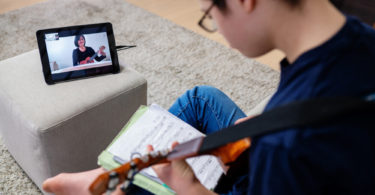


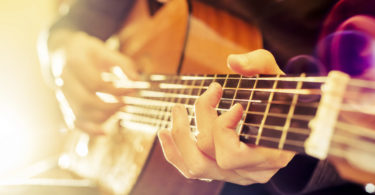
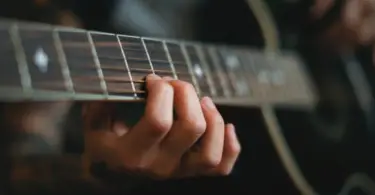
Start the discussion at talk.hearthemusicplay.com